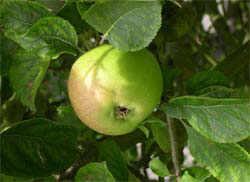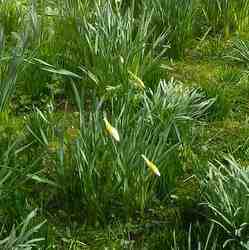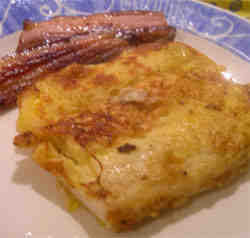Old Fashioned Apple Jelly Recipe
Posted by Fiona Nevile in Jam Jelly and Preserves | 106 comments
A green cooking apple
We always use cooking apples for apple jelly so that it is not too sweet and much more adaptable. For years I only thought of jelly as an accompaniment to meat. The jars opened and enjoyed but usually lost in the depths of the fridge. I cringe now at the thought of the great jellies that must have been wasted on us.
Over the past couple of years we have begun to discover the breadth of the jelly repertoire. Initially, we worked hard trying to make jelly with a good flavour, rather than the ultra sweet stuff that I remember as a child. I asked all my clients for tips. Armed with this unique knowledge, (most of them are good, inventive cooks) and a lot of experimentation we have finally made a small range of jellies that we think are good. This delicate apple jelly is one of the stars.
As we had all these pots of jelly crowding out the larder we were forced to become adventurous. We found that a decent dollop of a stronger jelly in a stew lifted the flavours. We ate it with cheese. We used it in casseroles, as a sauce base for pork and chicken and stirred it into hearty winter soup. We even tried in stir fries (great with a chicken or duck.
We found that dark meat and game cry out for a slightly stronger jelly, such as our damson or wild plum. We also make a punchy sloe and Bramley jelly which adds an extra fillip to a pheasant or venison dish. If we run out of the more raunchy jelly, Danny adds a slug of sloe gin, although I prefer the sharper fruity effect of damson gin. A dash of sloe or damson gin is super in stews, sauces and gravy. You can’t taste the alcohol, just a deep, mellow flavour.
Old Fashioned Apple Jelly Recipe
Ingredients:
- 4 pounds/1.8 kilos of cooking apples (windfalls are fine for this recipe)
- 2 UK pints/1140ml/5 cups of water
- Grated rind and juice of one large lemon
- White granulated sugar (the amount depends on the volume of juice extracted from the simmered, drained fruit. 1 pint/500ml/2 1/2 cups of juice to 1 pound/454gms of sugar. I always make sure that I have a 2 kilo bag of sugar in the larder, just in case I fancy making jelly)
Method:
- Wash the apples, cut out bad bits and chop roughly. There is no need to peel and core the apples.
- Carefully grate the lemon zest from the lemon (we use a zester but a fine grater will do. Try to avoid including the pith as this would make the jelly bitter).
- Place fruit and lemon zest in a large deep heavy bottomed saucepan, or preserving pan. Add the water and bring gently Bring gently to the boil and simmer very gently until all the fruit is soft and mushy (roughly 25 minutes, depending upon how ripe the fruit is).
- Pour the cooked fruit through sterilised muslin. (How do I sterilise muslin? See tips and tricks below). The muslin is often referred to as a “jelly bag”. We use tall buckets to catch the drips from the jelly bags. Rather than hang the bags (conventional method-between two stools) I find it easier to line a large plastic sieve with the muslin. This clips neatly onto the top of a clean bucket. The sieve is covered with a clean tea cloth to protect against flies, as the jelly bag generally drips overnight.
- Measure the apple juice the next day and pour it into a deep heavy bottomed saucepan. Add 454g/1 pound of white granulated sugar for each 570ml/1 pint/2 1/2 cups of juice.
- Add the juice of the lemon.
- Heat the juice and sugar gently, stirring from time to time. Make sure that that all the sugar has dissolved before bringing the liquid slowly to the boil. Continue to boil for about five minutes before testing for a set. (What is testing for a set? See tips and tricks below).
- Toss in a nugget of butter towards the end to reduce the frothing that often occurs.
- When jelly has reached setting point pour into warm sterilised jars using a funnel and ladle. (How do I sterilise jars? See tips and tricks below).
- Cover immediately with plastic lined screw top lids or cellophane tops secured with a rubber band.
Label when cold and store in a cool, dark place. Away from damp. (My jelly is too liquid. See Tricks and tips below)
Tips and tricks:
- What is a jelly bag?
A jelly bag is traditionally a piece of muslin but it can be cheesecloth, an old thin tea cloth or even a pillowcase. The piece needs to be about 18″ square. When your fruit is cooked and ready to be put in the jelly bag, lay your cloth over a large bowl. Pour the fruit into the centre of the cloth and tie the four corners together so that they can be slung on a stick to drip over the bowl. Traditionally a stool is turned upside down, the stick is rested on the wood between the legs and the jelly bag hangs over the bowl. We experimented and now line a sieve with muslin, place it over a bucket and cover the lot with clean tea cloths (against the flies). - How do I sterilise muslin/the jelly bag?
Iron the clean jelly bag with a hot iron. This also works with tea cloths. - What is Jam “set” or “setting point”?
Getting the right set can be tricky. I have tried using a jam thermometer but find it easier to use the following method. Before you start to make the jam, put a couple of plates in the fridge so that the warm jam can be drizzled onto a cold plate (when we make jam we often forget to return the plate to the fridge between tests, using two plates means that you have a spare cold plate). Return the plate to the fridge to cool for approx two minutes. It has set when you run your finger through it and leave a crinkly track mark. If after two minutes the cooled jam is too liquid, continue to boil the jam, testing it every few minutes until you have the right set. The jam is far more delicious if it is slightly runny. - How do I sterilise jam jars?
We collect jars all year round for our jelly, chutney and jam making sessions. I try to soak off labels and store the clean jars and metal plastic coated screw-top lids in an accessible place. The sterilising method that we used is simple. Just before making the jam, I quickly wash and rinse the jars and place them upside down in a cold oven. Set the temperature to 160c (140c fan-assisted). When the oven has reached the right temperature I turn off the heat. The jars will stay warm for quite a while. I only use plastic lined lids for preserves as the all-metal lids can go rusty. I boil these for five minutes in water to sterilise them. If I use Le Parfait jars, I do the same with the rubber rings.
Leave a reply







Thanks you for your reply. I’ve just used 3 pounds of sugar and I’ve ended up with my usual quantity of jelly – about three pints. It doesn’t taste any sweeter than my previous (small) batch, but the flavours are wonderful. Thanks to you and Lindsay.
Hi Willie M
If you’d used 3 pints of sugar you would have had more jelly but it would have been much sweeter.
Glad that the marmalade is still being guzzled!
I tried Lindsay’s spiced apple and cider jelly. It tastes even better than she suggests. I still have a few apples and I think I shall do it again. Just one query, however – probably because of my lack of experience at these things – it’s probably simple to the experienced. Last time, I got three pints of juice after straining, but it was much sweeter than if I had used apples and water. Therefore, I only used a pound and a half of sugar when I judged it to be sweet enough. However, I ended up with only half my normal amount of jelly. If I had used three pounds of sugar, would I have had my usual amount of jelly, and would there have been a difference in taste?
PS: I got so much help from this site when I was attempting to make marmalade early in the year – I might add that we are still enjoying it very much – and I’ve had so much guidance on my apple jelly. Thank you very much
I made a spiced apple and cider jelly, just add a cinammon stick and cloves to the apples and juice of an orange and use sweet cider instead of water. This created the most fantastic christmassy smell as I was boiling it and the jelly tastes lovely, especially just spread on some warm bread!
Hi Rosie
Great that the recipe worked for you!
Hi, have just made this recipe and the jelly is great ! Thanks so much. Now I need to find some more apples and make some more…
Hi Sandra B
Chutney keeps fr years and improved with age. Jelly should keep for a year if kept in a cool dry place.
Hi Julia
Those steam juicers sound terrific!
The preserving sugar with added pectin always works but it can leave a funny artificial taste. Much better to use some lemon juice.
Hi Gill
Jelly a bit sloppy is better than jelly that’s too hard. It gets firmer as it gets older. If you sealed the lids when the jelly was hot, it should keep for about a year.
Hi Emma
Great to hear that you’re enjoying the site! No open days at the moment but they’d be great when we have a bit more time.
Hi Dianne
You put the leaf in when it has almost set or keep on turning the jar – half an hour upright followed by half an hour upside down – with patience the leaf will settle in the middle of the jar. I use the latter method.
Hi, When making Crab Apple Jelly I want to include a Lemon Geranium leaf in the finished jelly.When putting the leaf into the jar with the jelly it always floats to the top. How can I make it remain in the middle of the jar.Thankyou.
thanks so much! have just made your apple chutney (with cranberries as suggested by the raisin hater) and the apple jelly…. I still have pounds of apples left on the plot but am about to start on the apple and rosehip jelly too. That’ll be christmas sorted (we have gallons of cider brewing for easter… what fun)What a great site. Do you ever have open days???
I love your site. I just made your old-fashioned apple jelly but was a bit blase about the lemon juice and subsequently it is a little on the runny side – it’s fine for my taste and since I’ve made 12 jars of it I don’t really want to re-boil it. My only concern is – will it still keep as long? Does it need to be quite ‘set’ in order to preserve it? I sterilised the jars and lids. Hope you can help.